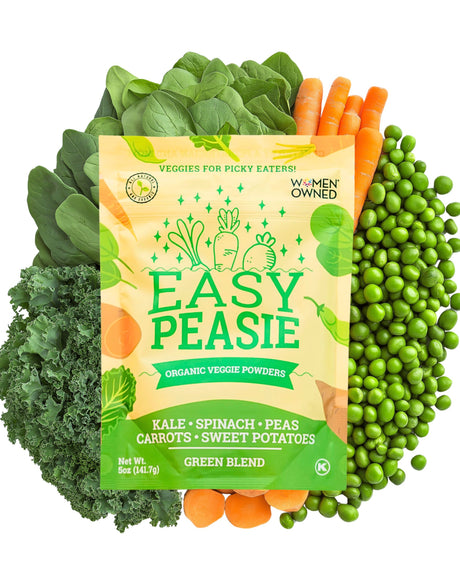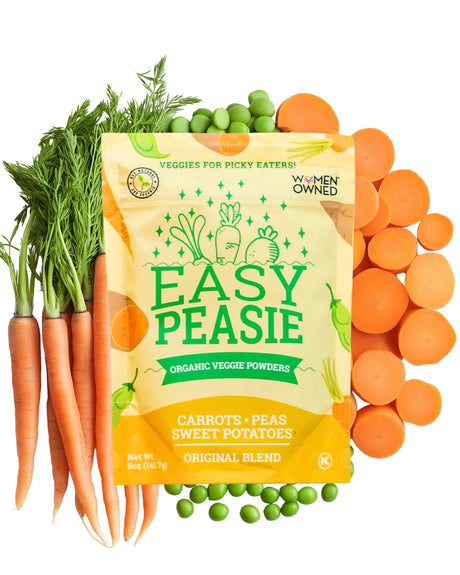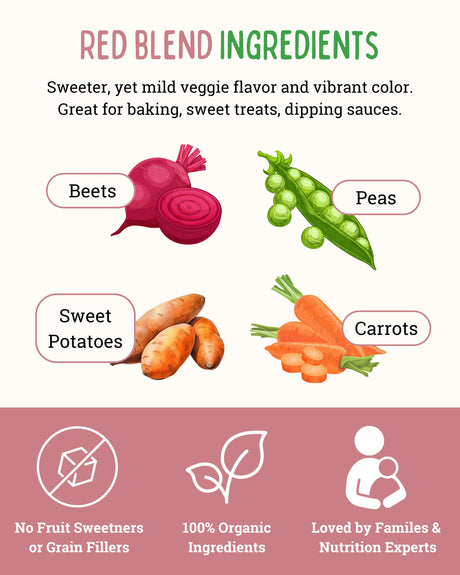Importance of Veggies in a Child's Diet
Veggies are the unsung heroes of a child's diet, packed with essential vitamins, minerals, and antioxidants vital for their growth and development. However, picky eaters often view veggies as the enemy, making it challenging to ensure they get their daily intake.
Despite the challenges, finding ways to incorporate veggies into their meals is crucial for their overall health and well-being.
Challenges of Dealing with Picky Eaters
The common struggle faced by parents dealing with picky eaters is introducing new foods, especially veggies, into their diet. This struggle can be challenging, but with creativity and patience, it's possible to introduce more veggies into their diet.

Creative Solutions for Sneaking Veggies into Meals
This blog provides creative solutions for parents dealing with picky eaters by incorporating veggies into meals in subtle ways. By using sneaky recipes and cooking hacks, parents can make veggies more appealing and palatable to even the most finicky eaters, ensuring their children receive the necessary nutrition without resistance.
1. Purees and Sauces
In the quest to sneak veggies into picky eaters' diets, purees and sauces can be a game-changer. These versatile culinary creations provide a seamless way to incorporate veggies into a wide range of dishes without the telltale appearance or taste that often sends picky eaters running for the hills.
Using Veggie Purees in Recipes
Veggie purees are a stealthy way to boost the nutritional value of your child's favorite foods. Whether it's blending carrots into spaghetti sauce or mixing cauliflower into mashed potatoes, purees seamlessly integrate veggies into dishes while maintaining a familiar taste and texture. Sneak them into recipes for soups, stews, pasta sauces, and even baked goods for an extra nutrient punch without detection.

Incorporating Veggies into Homemade Sauces
Vegetables can be incorporated into homemade sauces to enhance the flavor, texture, and nutritional content of dishes. For example, adding spinach to marinara sauce, roasted bell peppers to salsa, or grated zucchini to pesto.
Examples of Purees and Sauces to Try
Vegetable purees offer numerous culinary possibilities by incorporating them into meals.
By experimenting with sweet potato puree, butternut squash sauce, or roasted vegetable marinara, you can create quick and easy meal prep options, ensuring a variety of options for your family.
2. Hidden Veggie Recipes
Introducing hidden veggie recipes into your picky eater's diet is like serving up a nutritious ninja mission on their plate. These stealthy recipes ingeniously conceal veggies in familiar and kid-approved dishes, making it easier than ever to ensure your little ones get their daily dose of vitamins and minerals without putting up a fight.
Baked Goods with Veggies
Who says baked goods can't be a vehicle for veggies? Vegetables can be incorporated into baked goods to create a nutritious twist on classic treats.
By adding grated carrots, zucchini, or spinach, baked goods not only add moisture and texture but also boost nutritional value without compromising flavor. These veggie-packed treats are perfect for breakfast, snacks, and desserts.
Veggie-Infused Smoothies

Spinach is a versatile and kid-friendly vegetable that can be added to smoothies for a nutritious and delicious beverage. Blending spinach with fruits and other flavorful ingredients creates a delicious and nutritious beverage that even fussy eaters will enjoy.
This versatile and kid-friendly way to increase vegetable intake is a secret weapon for parents.
Creative Ways to Hide Veggies in Meals
Using creative kitchen techniques, sneaking veggies into meals can be a fun and creative way to surprise even picky eaters. From finely chopping veggies to mixing them into sauces, there are numerous ways to disguise veggies in dishes like spaghetti, mac and cheese sauce, or creamy risotto. You can also simply add a tablespoon of Easy Peasie Veggie Powder Blends to their favorite recipes.
3. Veggie-Enhanced Snacks
When it comes to snack time, incorporating veggies into your child's munchies is a clever way to sneak in extra nutrition between meals. These veggie-enhanced snack ideas are not only delicious but also packed with vitamins, minerals, and fiber, making them a win-win for both parents and picky eaters.
Homemade Veggie Chips
Swap out store-bought potato chips for homemade veggie chips made from nutrient-rich veggies like sweet potatoes, kale, or beets. Simply slice your veggies thinly, toss them with a drizzle of olive oil and a sprinkle of seasoning, then bake until crispy.
These crunchy and flavorful veggie chips are a healthier alternative to traditional snacks and are sure to be a hit with your little ones.
Veggie Dips and Spreads
Dipping veggies into creamy dips and spreads is a fun and tasty way to encourage kids to eat their greens. Whip up a batch of homemade hummus or guacamole and serve it alongside carrot sticks, cucumber slices, or bell pepper strips for a nutritious and satisfying snack.
You can also sneak extra veggies into your dips by blending in ingredients like roasted red peppers, spinach, or cauliflower for an added boost of flavor and nutrition.
Veggie-Loaded Trail Mixes and Snack Bars
Trail mixes and snack bars are great ways to incorporate veggies into your diet. Mix nuts, seeds, dried fruits, and veggie chips for a nutritious trail mix. Or, create your own snack bars with oats, nut butter, honey, and shredded carrots or zucchini for a satisfying snack.
4. Veggie-Based Substitutions
Incorporating veggie-based substitutions into your meals is a clever way to increase your child's vegetable intake without them even realizing it.
These creative swaps not only add extra nutrition to dishes but also offer unique flavors and textures that are sure to please even the pickiest of eaters.
Using Veggie Noodles Instead of Pasta
Vegetable-based pasta noodles, made from vegetables like zucchini, carrots, or sweet potatoes, offer a vibrant, nutritious alternative to refined pasta. Transform veggies into noodle-like shapes using a spiralizer or vegetable peeler, adding vibrant color to meals and providing extra vitamins, minerals, and fiber.
Cauliflower Rice and Veggie Pizza Crusts
Cauliflower rice and veggie pizza crusts are great ways to incorporate veggies into your child's favorite dishes. Replace traditional rice with cauliflower rice in stir-fries, fried rice, or burrito bowls for a low-carb twist. For a healthier pizza option, use cauliflower or zucchini crusts with sauce, cheese, and veggies.
Swapping out Traditional Ingredients with Veggies in Recipes
Enjoy your favorite recipes by incorporating veggies into them. Replace ground meat in meatballs or burgers with finely grated vegetables like carrots, onions, or spinach for moisture, flavor, and nutrients. Incorporate veggies into sauces, soups, and casseroles for extra nutrition. Experiment with different substitutions to find your child's favorite combinations.
5. Veggie-Centric Meals
Creating veggie-centric meals is a fantastic way to incorporate more vegetables into your child's diet while still offering delicious and satisfying dishes. These meals put vegetables in the spotlight and make them the star of the show, enticing even the pickiest of eaters to enjoy their veggies in creative and flavorful ways.
Build-Your-Own Veggie Bowls
A variety of vegetables, including a variety of fruits and vegetables, can be added to a build-your-own veggie bowl for a fun and interactive mealtime experience. This allows children to choose their favorite ingredients, making mealtime both nutritious and exciting.
Veggie-Based Stir-Fries and Skillet Meals
Sophisticated stir-fries and skillet meals are versatile dishes that incorporate a variety of vegetables, making them a great way to enjoy a variety of colorful and nutritious options.
These versatile dishes are perfect for a variety of tastes.
Veggie-Packed Soups and Stews
Vegetables, such as onions, carrots, celery, potatoes, and leafy greens, provide a nutrient-rich base for soups and stews. These hearty meals are filled with protein and flavor, making them perfect for pairing with whole-grain bread or crackers for a satisfying, hearty meal.
6. Getting Kids Involved
Getting kids involved in the kitchen and in the process of selecting and preparing vegetables can foster a positive relationship with healthy foods and encourage them to try new things.
By making cooking and shopping for veggies a fun and interactive experience, you can instill lifelong healthy eating habits in your children.
Fun and Interactive Cooking Activities
Engage your kids in fun and interactive cooking activities that involve preparing and cooking vegetables. Let them help wash and chop veggies (under adult supervision, of course), mix ingredients, and assemble meals.
Encourage creativity by allowing them to come up with their own veggie-inspired recipes or participate in themed cooking challenges. Not only does this empower them in the kitchen, but it also increases their excitement and willingness to try new foods.
Involving Kids in Grocery Shopping for Veggies
Take your kids along to the grocery store or farmers' market and involve them in the process of selecting fresh vegetables. Teach them about different types of veggies, how to choose ripe produce, and the importance of incorporating a variety of colors into their diet.
Consider giving them a shopping list with specific veggies to find or let them pick out one new vegetable to try each week. This hands-on experience not only educates them about healthy eating but also helps them feel more invested in their food choices.
Gardening and Growing Veggies at Home
Growing veggies in the backyard or on windowsills can be a fun way to get kids excited about the plants. Involving them in every step, from planting seeds to watering and harvesting, can be rewarding and encourage them to taste and enjoy the vegetables they grow themselves.
7. Overcoming Resistance
Encouraging picky eaters to embrace vegetables can be challenging, but with patience and persistence, it's possible to gradually expand their palate and instill healthier eating habits.
Patience and Persistence
It's essential to approach the process of introducing vegetables to picky eaters with patience and persistence. Understand that it may take multiple exposures to a new vegetable before a child is willing to try it, let alone enjoy it.
Keep offering a variety of vegetables in different forms and preparations, even if they are initially met with resistance. Be patient and continue to model positive attitudes towards vegetables, reinforcing the message that it's okay not to like something at first, but tastes can change over time.
Role Modeling Healthy Eating Habits
Children learn by savoring vegetables and eating healthy foods. By role modeling healthy eating habits, children can overcome resistance to vegetables.
Avoid labeling foods as "good" or "bad" and enjoy a variety of vegetables in meals. Involve your child in meal planning and preparation, and let them see you enjoying vegetables.
8. Sneaky Tips for Success
When it comes to getting picky eaters to embrace vegetables, a few sneaky strategies can make all the difference in encouraging them to eat more nutritious foods without a fuss.
Gradual Introduction of Veggies
Introducing vegetables gradually to your child can help them adjust to new flavors and textures. Start by incorporating small amounts of vegetables into familiar dishes, gradually increasing the variety over time. This gradual approach helps your child develop a taste for vegetables without overwhelming their palate.
Camouflaging Veggies with Familiar Flavors
Incorporate vegetables into dishes with strong flavors or textures to trick picky eaters into eating more. Puree vegetables and mix them into sauces, dips, or spreads to add nutrients without significantly altering taste. This sneaky strategy helps children enjoy vegetables without realizing it.

Making Meals Visually Appealing
Presentation matters when serving vegetables, as it entices picky eaters to try new foods. Create visually appealing vegetable platters with a variety of shapes, colors, and textures, using cookie cutters to shape vegetables into fun shapes. This makes eating vegetables more enjoyable.
Recap of Strategies for Sneaking Veggies into Picky Eater's Diets
Vegetables can be incorporated into children's diets through various ways, including veggie-based substitutions, purees, and hidden recipes. These strategies cater to picky eaters by blending vegetables into sauces, disguising them in baked goods, and serving them interactively.
Importance of Veggies for Children's Health
Vegetables offer a variety of essential nutrients, including vitamins and minerals, which are crucial for children's growth and health. Consuming a variety helps reduce the risk of chronic diseases and promotes immune function, ensuring a healthy digestive system.
Experiment with Creative Ways to Incorporate Veggies into Meals
Embrace creativity in incorporating veggies into your child's diet by experimenting with various recipes, ingredients, and presentation techniques. Remember that every child is unique, so experiment and be patient. Explore new ways to make vegetables a delicious and enjoyable part of your child's diet, helping them develop a lifetime love for vegetables.
Leave your comments below; we love to hear from you! And don't forget to follow EasyPeasie for more veggie info and convo on YouTube, Facebook, and Instagram! ~ThePeas













